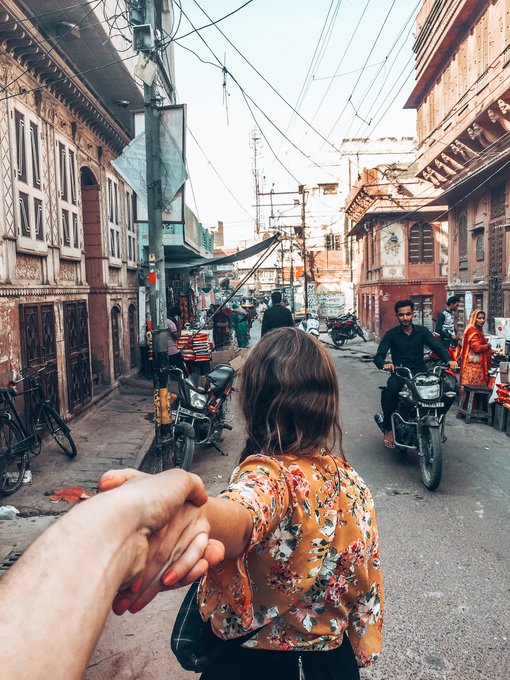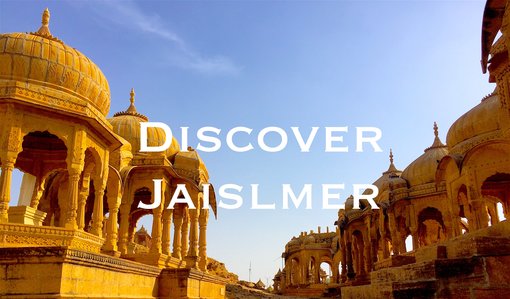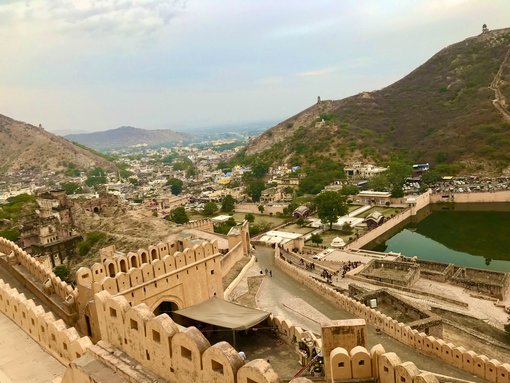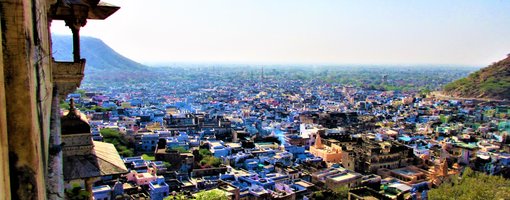Rajasthan, the largest state in India, is an exotic land of palaces, forts, culture and history. Indeed, the classic Golden Triangle, compromising of Delhi, Agra and Jaipur, is probably the most traversed tourist route in the country. We have been to Rajasthan a couple of times and love travelling in this beautiful region of India. Many of the forts and palaces have been converted into beautiful hotels and some of them are surprisingly affordable to stay in.
Another option is to stay in one of the many of the traditional havelis (mansion or townhouse), which also offer an authentic Rajasthani experience. From the Thar Desert to the pink city of Jaipur, there is something magical about Rajasthan. Here choose our eleven highlights of India's most captivating state:
Jaipur
Known as the Pink City for its pink sandstone buildings, Jaipur is one of the major stops on the Golden Triangle. In all honesty, we didn't find Jaipur itself to be quite the fairy-tale city that we imagined. In fact, it is hot, crowded, dusty and isn't short of the hustle factor. Having said that, it has some stunning forts and palaces which shouldn't be missed.
Jaipur is home to two forts.
The magnificent Amer Fort (otherwise known as the Amber Fort), built in the 15thcentury, is perched on a hill just outside the city. The Mughal-style architecture features ornate archways, attractive courtyards and hand-painted walls and ceilings. Additionally, every evening a spectacular light and sound show takes place. The less impressive Narhargarh Fort is located in the Aravalli Hills and was constructed as a summer palace for the royal family. Its most outstanding features are its frescoes and marble engravings. It's worth visiting for the sweeping views of the city, especially at sunset.
Hawa Mahal is more famously known as the Palace of the Winds and is Mughal in style. From behind the sandstone façade, the women of the royal household would covertly observe the street activities through the latticework openings. The nearby City Palace is Rajput in style and is still used as a residence of the royal family today. Nevertheless, much of it is open to the public. As well as several courtyards and galleries, it is also home to a museum and temple.
Another popular attraction is the Janta Mantar, an 18th century astronomical observation site and UNESCO World Heritage Site. It is home to twenty instruments including the largest sundial in the world.
Jaisalmer
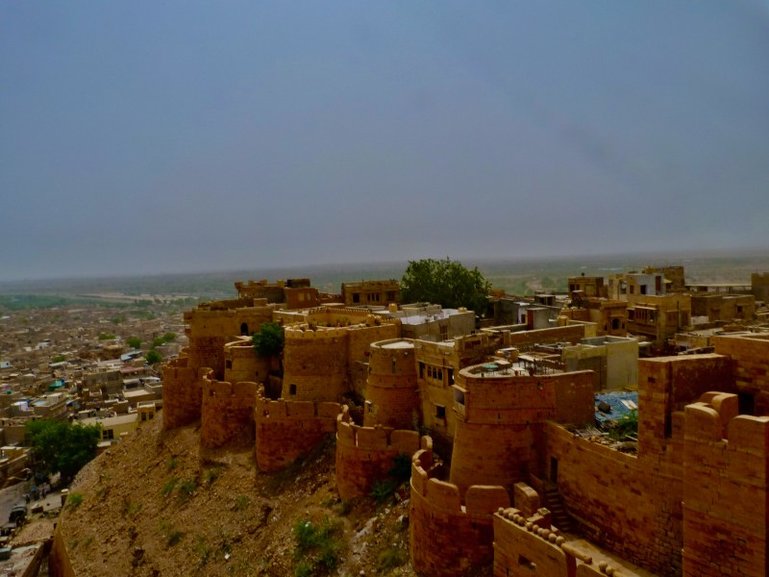
The Fort
Built from yellow sandstone and known as The Golden City, Jaisalmer rises above the Thar Desert like a mirage. With a magnificent 12th century fort at its centre, Jaisalmer is both exotic and unique. Within the fort walls, narrow lanes are lined with havelis, temples and a royal palace. An important stop on the camel trade route, the city is steeped in history and shrouded in mystique.
Taking a camel safari is the quintessential Jaisalmer experience. The touts had even infiltrated our bus and were attempting to sell us a safari while we were still on route to the city! It is wise to do your research prior to arrival and choose carefully. If you aren't keen on riding a camel, it's possible to take a tour to the sand dunes and stay overnight in a desert camp.
Back inside the fort, one of the main attractions are the beautifully preserved Jain temples that date back to the 15th/16th centuries. Consisting of a complex of seven interconnected temples, they were built to protect from Mughal invaders. The architecture of the temples is stunning with intricate sandstone carvings on the pillars and walls. Jainism is one of the oldest religions in the world and Jains are encouraged to seek spiritual perfection through non-violence and asceticism.
Bikaner
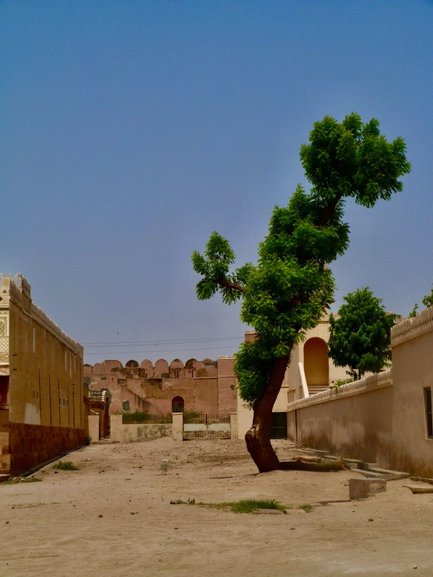
Bikaner Fort
Located in the Thar Desert and on the trade route between central and western Asia, Bikaner is another of Rajasthan's overlooked gems. With a beautiful fort, several temples and an atmospheric old town, it's a small city worthy of exploration. Bikaner is home to an annual camel fair and camel safaris into the desert can be undertaken from the city. While the crowds head to Jaipur and Udaipur, we loved the fact that Bikaner is largely undiscovered by foreign tourists. Consequently, the locals were friendly and welcoming. What's more, we didn't feel that we were being ripped off at every opportunity.
Bikaner's fort, Junagarh, is well-maintained and was built by Raja Rai Singh in the 15th century. Although we had trudged through an abundance of forts and palaces at this stage of our journey and were beginning to feel ‘palaced out', we were nevertheless most impressed by Junagarh Fort. Rajput and Mughal in style, there were intricately designed wall paintings, glass and lattice work galore and lots of nooks and crannies to explore. Additionally, the fort contained ornate archways screens and corridors together with displays of a variety of royal artefacts.
The Karni Mata Temple is twenty-six miles from Bikaner and is otherwise known as the Rat Temple. Home to 20,000 scurrying rats, it is supposedly auspicious if a rat eats the food offered to it. Many of the buildings in the Bikaner's old town are built from red sandstone. Rampuria Haveli is the known as the ‘Pride of Bikaner' – a splendid haveli with a slightly Victorian influence. The Bhandasar Jain Temple with its colourful frescoes and elaborate mirrorwork has a unique foundation made from a mixture of ghee and mortar. A colourful spice market can be found on the edge of the historical centre.
Jodhpur
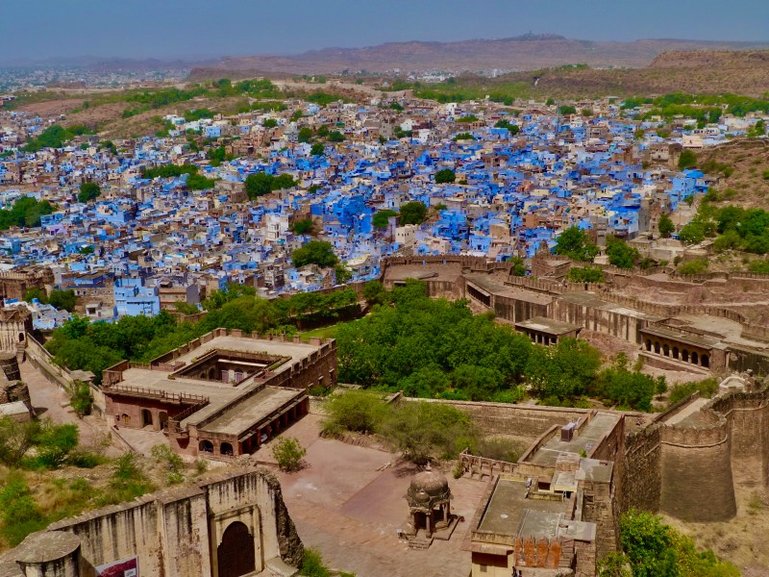
The Blue City of Jodhpur
Known as the Blue City, Jodhpur is so-called because many of the buildings are painted in the colour blue, which is sacred to devotees of Shiva. The main attraction in Jodhpur is the imposing Mehrangarh Fort which overlooks the city from a cliff top. The area at the back of the fort offers the best perspective of the mesmerising sea of blue buildings.
The fort itself is as impressive within as outside. It contains an extensive collection of royal memorabilia and the rooms are incredibly decorative and colourful, especially Takhat Mahal – the party parlour.
On the way down, it's worth a stop at Jaswant Thada, an intricately carved cenotaph which was built in honour of Mahajara Jaswant Singh II.
Exploring Navchokiya, the blue narrow streets beneath the fort, is fascinating. It's less busy than the old city and very photogenic. Also worth a visit is one of the last palaces to be built in India, Umaid Bhawan. Built in 1944, it has 347 rooms and is one of the largest private residences in the world. In addition to being a palace, a part of which is still occupied by the royal family, it is a hotel.
Mount Abu
There is a precipitous winding road that leads to Rajasthan's only hill station, Mount Abu, 1220m above sea level. Set in the Aravilla Mountains. it's a popular retreat from the intense desert heat all year round. Scenically located, the town is known for such outside activities as trekking, caving, rock climbing and camping.
One of the best hikes culminates at Dhrudhiya Waterfall which are particularly spectacular during the monsoons. Additionally, the trek to the highest peak of Guru Sikha, offers panoramic views from the summit. The trail passes the Guru Dattatreya Temple on route. At Mount Abu Wildlife Sanctuary leopards, sloth bears and wolves are amongst the abundant wildlife that can be spotted.
Back in town, the five Dilwara Jain Temples, which were built between the 11th and 13th centuries, feature impressive ornamental carvings. Shopping in Mount Abu is a colourful experience offering locally produced handicrafts galore. Sarees, bangles, puppets, quilts and sandalwood are among the popular items which can be purchased. Mount Abu is also home to Nakki Lake, a man-made reservoir where it's possible to hire boats and take in the scenery from the water. In the early evening, crowds gather at Sunset Point to watch the sun sink over the mountains.
Bundi
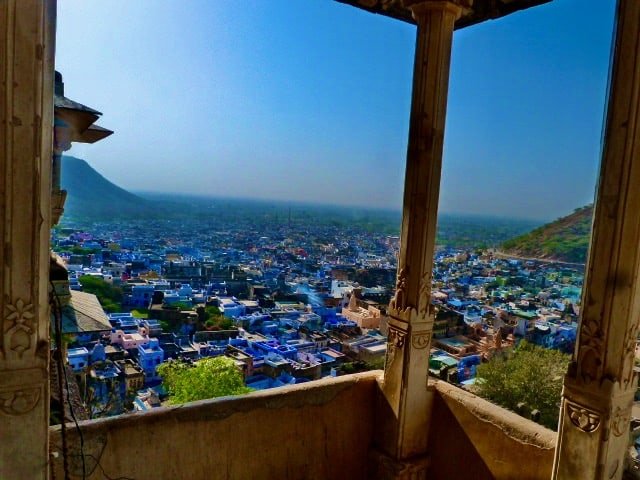
The View of Bundi from the Palace
Bundi is one of the less visited Rajasthani cities and indeed, that is what makes it so appealing. We stayed at the Dev Niwas Heritage Hotel, a traditional haveli with spectacular views of the city from the roof terrace. Unfortunately, we were both suffering from food poisoning when we arrived there. The staff were incredibly helpful and brought a constant supply of drinks with honey and toast to our room when we weren't able to make it up to the roof terrace!
Bundi itself is a small, but friendly city and deoid of the constant hassle that is often present in destinations which are favoured by tour groups. As we explored the narrow streets, shopkeepers called out greetings and waved good-naturedly. Some of the murals on the shopfronts and buildings are beautiful – both intricate and colourful.
As with most cities in Rajasthan, Bundi is home to a palace.
The entrance, known as Hathi Poi, means elephant gate and indeed, visitors walk under a pair of elephant sculptures to enter. Although the building isn't as well-maintained as the better-known palaces, there are some stunning murals and paintings depicting Indian mythology.
Pushkar
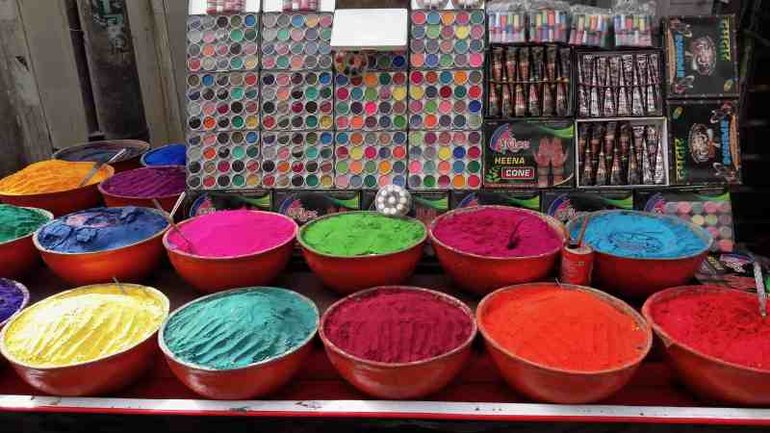
Pushkar Bazaar
The town of Pushkar is located next to a holy lake and is famous for its camel fair, which takes place every November for two weeks. It's a colourful spectacle exuding a carnival like atmosphere and attracts around 400,000 people. Tents and stalls are set up in the desert and camel and horse traders arrive from all over India. Furthermore, the event honours the Hindu God, Brahma and attracts worshippers from far and wide.
Pushkar, however is fascinating at any time of the year. Hindu pilgrims are drawn to the town to swim in the holy water from one of the fifty-two ghats and worship at one of the temples. Incredibly there are around five hundred temples in this small town including a rare temple dedicated to Brahma, the creator of the universe, according to Hindus. Aarti (fire) ceremonies are held lakeside every evening. The sound of drumming, chanting and the tingling of bells can be heard emanating from the ghats. Indeed, watching a ceremony as the sun goes down is bewitching and captivating experience.
The town's bazaar is a riot of colours and brims with hippie cafes, juice bars and handicrafts stalls. There are elephant pants, Rajasthani style throws and patchwork bags aplenty. Being a holy town, Pushkar is vegetarian and officially alcohol is banned. However, bhang, a lassi laced with cannabis leaves is available in several cafes.
Udaipur
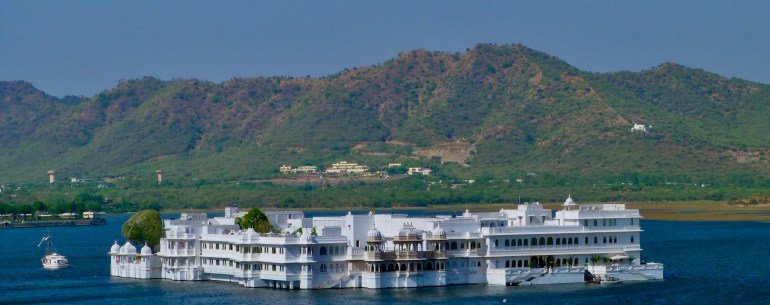
Taj Palace Hotel on Lake Pichola
The romantic lakeside setting of Udaipur is on most traveller's agenda and there is a reason it is so popular with tour groups. Known as the City of Lakes, for the four lakes that it surrounds. it has an abundance of impressive Rajasthani architecture and is rich in culture and history. The focal point of picturesque Lake Pichola is the beautiful Taj Palace Hotel, which has been featured in many a movie including James Bond's Octopussy. It is at night when the lights from the hotel illuminate the water that it is at its most stunning.
The Udaipur City Palace and museum is a highlight of any visit to Udaipur. The grandeur of the Mewer Palace is awe-inspiring from the tinted glass and mirrorwork to the intricate art, balconies and courtyards. Additionally, check out the Monsoon Palace for sweeping views of the lake, which is especially magical at sunset.
At Bagore-Ki-Haveli, an 18th century haveli next to the lake, there are nightly performances of traditional Rajasthani music and dance. Additionally, the haveli's museum is fascinating, albeit somewhat creepy - one room is filled with colourful puppets, while another is dedicated to turbans. The turbans are each placed on the head of a waxwork head, every one of them with their own unique facial features.
Ranthambore National Park
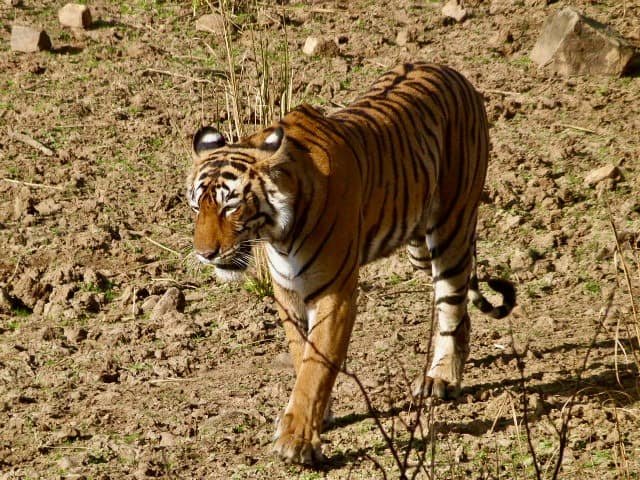
Tiger Spotting!
If you want to see a tiger in the wild in India, Ranthambore National Park is one of the best places to head for. The nearest town to the national park is Sawai Madhopur and this is where most people stay and arrange their safaris from. Not only is the park home to tigers, but also leopards, sloth bears and sambar deer, among others. We booked our safari through our accomodation and were lucky enough to watch a tiger stalk a young deer at close range for an hour or so. Although the deer was oblivious initially, it moved fast when it realised the tiger was there and swiftly made its escape. It was, indeed, an incredible experience and one we will never forget. We even spotted a second tiger as we were leaving the park, along with an abundance of monkeys.
In addition to tiger spotting, there is an impressive fort within the park, which is well worth visiting. The fort is situated on a hill-top and is spread over an area of around 12km, majestically looking over the national park. You will encounter numerous grey langurs as you make your way up the steps past various colourful shrines. The fort is well-known for its Ganesh temple and additionally, it is home to a Jain temple and a Mosque.







